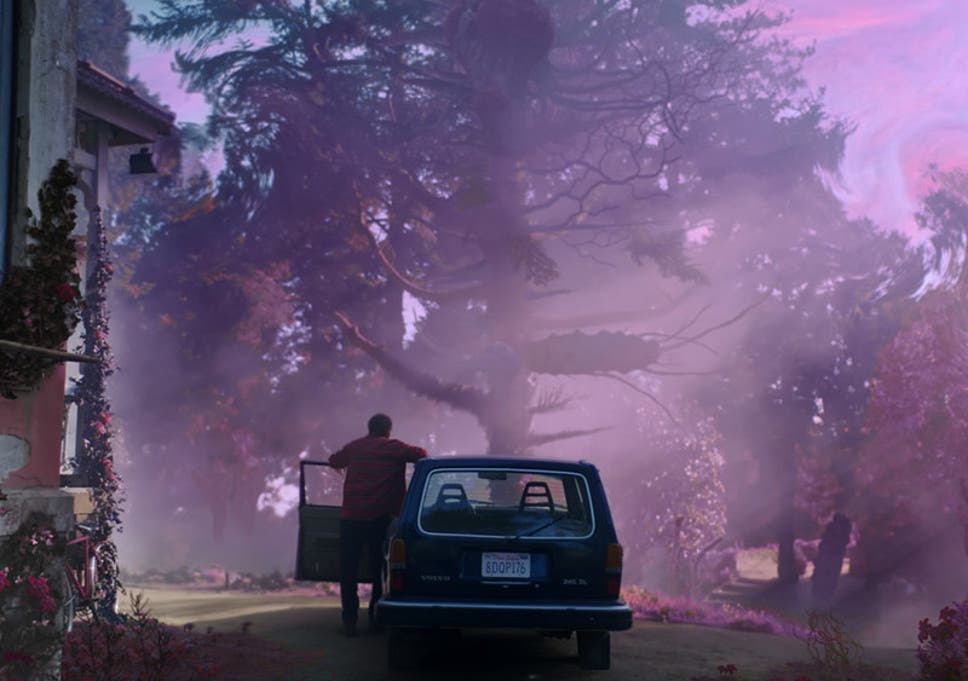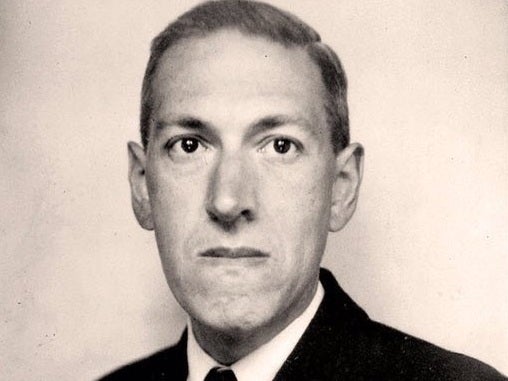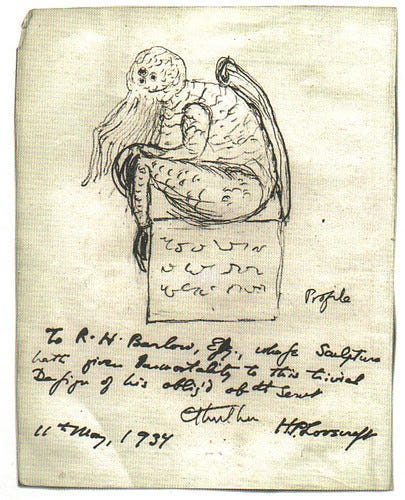Revising Lovecraft: The Mutant Mythos

By Paul StJohn Mackintosh OCTOBER 17, 2018
A VAST TIDE of Lovecraftian fiction, revisionist or otherwise, is published every year. I remember reading a claim — which I’ve been unable to track down — that roughly 50 percent of titles published each year in the weird/dark fiction metacategory are more or less Lovecraftian. Why do we see this current fascination with Lovecraft, and why is revisionism necessary in the first place?
A VAST TIDE of Lovecraftian fiction, revisionist or otherwise, is published every year. I remember reading a claim — which I’ve been unable to track down — that roughly 50 percent of titles published each year in the weird/dark fiction metacategory are more or less Lovecraftian. Why do we see this current fascination with Lovecraft, and why is revisionism necessary in the first place?
Enough unreconstructed pastiches, homages, and Mythosian works have thrived in the ever-expanding universe of the Lovecraftian canon to make a case for continuing to mine the same seam without revision, despite its impurities and toxic contaminants. There are very good reasons, though, why fidelity to Lovecraft can’t be continued unproblematically anymore — reasons that transcend accusations of virtue signaling or kneejerk political correctness. Lovecraft scholar Robert M. Price, for example, attempted to valorize Lovecraft from an alt-right perspective in his keynote speech at NecronomiCon 2015; right-wing reappropriation of Lovecraft looks to be on the rise, and some readers and fans (such as Michel Houellebecq) appear genuinely ready to swallow Lovecraft’s ethnic bigotry and apocalyptic nihilism whole. In these circumstances, revisionist Lovecraftian fiction looks like a proper and sufficient counterbalance.
As a reader, one may be able to enjoy Lovecraft without agreeing with him. As a writer, though, one almost certainly won’t be able to produce meaningful, enduring, or even enjoyable Lovecraft-inspired work (for anyone other than white supremacists) without understanding the author’s underlying credo. In short, you can’t understand the artist without engaging the bigot. The title of Alison Sperling’s 2017 LARB review on Lovecraftian scholarship “Acknowledgment Is Not Enough” cuts more ways than one: it’s impossible to understand the writer’s intellectual roots and concerns, even his aesthetic, without tackling his mindset. It’s also become almost impossible to write well within Lovecraft’s Mythos without addressing what it was a myth of. Revisionism is not just The Right Thing, it’s also The Smart Thing.
You can’t understand Lovecraft’s conflation of personal miscegenation and hereditary flaws with outside threats, social decay, and vast panoramas of evolution across Deep Time without first understanding the turn-of-the-century traditions within mainstream experimental literature and polemical pseudo-scientific writing that influenced him. Lovecraft may have been a bizarre, original outlier in the context of 1920s horror or science fiction, but he was completely comprehensible (and even representative) within these older and larger traditions. Many other far-right literary figures on both sides of World War I share much of Lovecraft’s grab-bag of Symbolist, Decadent, Spenglerian, and world-weary fin-de-siècle values and tropes. Period clichés of Yellow Book dandyism and racial doomsaying abound in this context. D’Annunzio, Hamsun, and Jean Lorrain would all have recognized a kindred spirit in Lovecraft, and period readers of Max Nordau’s Degeneration and sponsors of the Race Betterment Foundation would recognize familiar ideas, thinly recast, in Lovecraft’s oeuvre.
You don’t need the vast apparatus of Lovecraftian scholarship, or Lovecraft’s voluminous correspondence, to deduce that nasty racist statements and attitudes are likely to start falling out of such a mix once you shake it. Even S. T. Joshi, the arch-priest of Lovecraftian traditionalist connoisseurship, provided a confirmation of such critical perspectives in his book H. P. Lovecraft: The Decline of the West (1990).
It’s not hard to see how Lovecraft’s intellectual and aesthetic stance correlates with Theodore Millon’s definition of the insular paranoid personality subtype: “Reclusive, self-sequestered, hermetical; self-protectively secluded from omnipresent threats and destructive forces; hypervigilant and defensive against imagined dangers.” Lovecraft’s paranoid pathology is contiguous with his social bigotry, which is also contiguous with his aesthetic. Clinical paranoia is deeply associated with exactly the kind of socially marginal existence that the “Old Gentleman” endured in reality.
How to Revise Lovecraft
Given this context, revisionist Lovecraftian fiction has a heavy load of toxic waste to haul. What, then, makes it work when it actually succeeds? One outstanding example, Victor LaValle’s novella The Ballad of Black Tom (2016), has practically cornered this market, winning a Shirley Jackson Award and a finalist’s placing for both the Hugo and the Nebula Awards, among other honors. To my mind, it’s not just LaValle’s account of historical and modern African-American experiences that elevates his work. His terse, laconic prose certainly helps — and it is a refreshing contrast to his source material, the overwrought prose of “The Horror at Red Hook,” where Lovecraft’s protagonist, the detective Thomas Malone, runs into a Beardsleyesque entourage of creatures: “[G]oat, satyr, and aegipan, incubus, succuba, and lemur, twisted toad and shapeless elemental, dog-faced howler and silent strutter in darkness.”
Essentially, though The Ballad of Black Tom is successful because it captures the horrific imagination at play in basic Lovecraftian themes. (Thomas Malone’s fate, for instance, and the reasons for it, are revoltingly evocative and persuasive.) LaValle reads like James Baldwin transposed into cosmic horror and Black Tom articulates sentiments that, ironically, Lovecraft himself might have shared. Ryan Teitman’s review of the novella in the Philadelphia Inquirer, which declared that the story “Out-Lovecrafts Lovecraft,” accurately applauds both LaValle’s ability to write straightforward horror and his ability to infuse that horror with broader social concerns.
Other revisionist writers often lack LaValle’s mastery of Lovecraft’s horrific dimensions. Kij Johnson’s The Dream-Quest of Vellitt Boe (2016) subtly, lovingly subverts Lovecraft’s The Dream-Quest of Unknown Kadath in more ways than just inserting female protagonists and a struggling women’s college into the narrative. The charming, whimsical work evokes Jack Vance at his most fantastic, but is it Lovecraftian? What does it mean to particularize and detail Lovecraft’s Dreamlands down to tractors and bakeries, when the whole point of Lovecraft’s oneiric realm is a paranoid rejection of reality? Johnson captures the world-building aspect of Lovecraft beautifully, but she sidesteps much of the horror implicit in his paranoia.
Put a similar approach into a different context, though, and it works just fine. Interviewed in the Lovecraft eZine, LaValle described his evocation of New York:
What I wanted to get across most about uptown as a whole was the sense of life and community, exactly the things Lovecraft missed, or simply couldn’t see. His depictions of the immigrant neighborhoods in Brooklyn were so baffling to me because I simply couldn’t recognize the kinds of places he feared as exactly the kind of places I’m so happy I grew up in, and where I still live now. So my depictions of Harlem had to work as a kind of corrective.
Nick Mamatas takes a different approach: he has graduated from a series of mashups which recast the Mythos in the vein of the Beats (Move Under Ground) or Hunter S. Thompson (The Damned Highway) to offer what might be the last word about the cult of Lovecraft, the detective drama I Am Providence (2016), where the decaying corpse of a murder victim struggles to solve a murder at a Lovecraft convention.
Like most pulp authors, Lovecraft was writing escapist fiction. Why should anyone want to escape to a malign cosmos such as Lovecraft’s? Crime writers struggle with similar questions every time they come up with a fresh atrocity. But genre fiction is all about conventions — in more than one sense, as any fan or observer of cosplay can attest.
As Joyce Carol Oates suggests in “The King of Weird,” her 1996 New York Review of Books article,
Readers of genre fiction, unlike readers of what we presume to call “literary fiction,” assume a tacit contract between themselves and the writer: they understand that they will be manipulated, but the question is how? and when? and with what skill? and to what purpose? However plot-ridden, fantastical, or absurd, populated by whatever pseudo-characters, genre fiction is always resolved.
The Risks of Revision
One risk that revisionists sometimes face is taking Lovecraft too seriously, which sometimes leads to cutting away the tentacles (and other weird stuff) in favor of dark psychological realism. Just like Bram Stoker or Sir Arthur Conan Doyle, who Neil Gaiman spliced brilliantly with the Mythos in “A Study in Emerald,” Lovecraft is the creator of one of the great modern myths, and just like with those predecessors, the myth factor — and the fun factor — is the one thing you lose if you start to take the creator too seriously as a thinker, as Michel Houellebecq arguably did with his H. P. Lovecraft: Against the World, Against Life (1991). The pulpy, mythic flavor of the Mythos is also what explains Lovecraft’s pervasive influence in modern culture. As editor Paula Guran says in her introduction to her 2016 anthology, The Mammoth Book of Cthulhu:
Cthulhu and the “Cthulhu Mythos” (more properly the “Lovecraft Mythos”) has become a brand name recognizable far beyond genre in every facet of popular culture: mainstream literature, gaming, television, film, art, music; even crochet patterns, clothing, jewelry, toys, children’s books, and endless other tentacled products.
Chaosium’s Call of Cthulhu is the quintessential Lovecraftian escapist experience, the Pepsi of RPG franchises, second only to D&D. A large subset of Lovecraft fans aren’t looking for probing explorations of existential dread and cosmic indifference. They’re looking for shibboleths, signposts, and landmarks within that same imagined country: sniffing for any mention of shoggoths or tomes so that they can get more of the same Lovecraftian buzz. “Lovecraft is an adolescent fascination,” observes Mamatas in his LARB essay on the writer. “Lovecraft demands the careful attention that only a teen boy with little else to do — no high school romances, no sports practice — can muster.”
That idea may characterize an infantile geekery and fanboy culture, as pernicious as Gamergate at its worst, but it literally underwrites all kinds of endeavor, from the woefully derivative to the sublime. Yes, it may help explain why some Lovecraft fans become so defensively hostile around their idol and around traditional Lovecraftian fiction in general. It’s tempting to dismiss challenges to your little imagined world as PC snark when you don’t want to face up to the sentiments underpinning its insidious appeal. But that is not the same argument as genre fiction versus literary fiction, entertainment versus edification. If Lovecraft covered both bases, even slightly, that feat in itself is surely worth emulation.
I doubt a writer can create quality work in the revisionist Lovecraftian vein by simply cutting out the squamous bits. If you’re not looking to play in that imagined world, you’ll lose those who are drawn to world-building. And those omissions won’t answer the prayers of a genre writer looking to be taken seriously: genre writers of every stripe struggle with that anxiety, but ditching the identifying marks of your particular subgenre may not help cure it. As Mamatas says, “Lovecraft is a perfectly capable writer when it comes to pacing, to invention, to story logic, and even when it comes to generating the occasional quotable phrase — all the attributes needed for a successful career in the pulps.” An author who revises away those qualities may disappoint more than just Lovecraftian reader expectations.
Revising and Revitalizing
The escapist aspects of Lovecraftian fiction are open to one obvious interpretation: the Mythos creates a fictive safe space for the reader’s inner racist. Fortunately, I don’t think applies overall, but it is relevant to the case for revisionist Lovecraftian fiction in the first place. This is where I disagree with a very able, black, and sometimes Lovecraftian writer Craig Gidney, who argues that Lovecraft “turned his eugenic/racist/misanthropic beliefs into art. Uncomfortable ugly art, but art none the less. It’s a great way to stroll in the mindset of a racist.” One can enjoy and appreciate Lovecraft’s fiction as art, but reading it to stroll in the mindset of a racist surely implies more than just enjoyment for some.
I don’t think that inoculating Lovecraftian narratives with POC protagonists, or reframing them from the POV of the Other, accomplishes very much unless you dig deeper into the intellectual, cultural, and social legacy underpinning those stories. On this issue, in my opinion, Matt Ruff’s Lovecraft Country (2016) falls short. Inspired as it is to incorporate The Negro Motorist Green Book into modern fantastic fiction, with a cast of feisty 1950s African-American protagonists fighting dark white occult conspiracies in a landscape where any careless rest stop might mean death, Ruff’s narrative doesn’t delve deeply enough into the traditions behind Lovecraft himself, or Lovecraft Country. There just isn’t much Lovecraft to justify the title. Intense nostalgia and an intense sense of place make for strong subsidiary elements in Lovecraft’s appeal, not least for world-building fiction and RPGs, and that blood-and-soil ethic deserves deep interrogation as part of Lovecraft’s paranoid sensibility and racism. Plus, if you’re going to rehash Lovecraft from the viewpoint of his supposed menaces, you should approach with the sensitivity and imaginative intensity of Ruthanna Emrys in her Winter Tide (2017). Simply flipping the Lovecraft narrative is a tactic that can get old fast.
Tap more deeply into the provenance of Lovecraft’s ideas, however, and you find an excellent set of tools for probing and dissecting the kind of social and cultural anxieties that form the basis of great fiction, and great horror. Lovecraft’s work is a great way to stroll in the mindset of a proto-fascist. It’s correspondingly helpful when tackling such ideas in their modern guises, as in, for example, the writing of Michel Houellebecq, or the dogmas of Steve Bannon, and Robert Price.
In one of his most famous passages, the opening of “The Call of Cthulhu,” Lovecraft’s protagonist Francis Wayland Thurston warns that:
The most merciful thing in the world, I think, is the inability of the human mind to correlate all its contents […] some day the piecing together of dissociated knowledge will open up such terrifying vistas of reality, and of our frightful position therein, that we shall either go mad from the revelation or flee from the deadly light into the peace and safety of a new dark age.
Umberto Eco’s typology of ur-fascism emphasizes that “no syncretistic faith can withstand analytical criticism” — i.e., the appeal of fascism lies in its brutal suppression of any attempt to correlate the mind’s contents. The siren call of Cthulhu is the nihilistic appeal of the peace and safety of that new dark age. Characteristically, Mamatas picked up on that passage brilliantly in his vertiginous short story “On the Occasion of My Retirement,” where the protagonist’s victims are coralled into the agony of correlating their minds’ contents.
Fearful Revisionism
The one key ingredient for powerful revisionist Lovecraftian fiction, in my view, is fear. Lovecraft himself kicked off the definitive statement of his own focus and intent, the essay “Supernatural Horror in Literature” (1927), by declaring that “the oldest and strongest emotion of mankind is fear, and the oldest and strongest kind of fear is fear of the unknown.” For better or worse, few of his Terrors are now actually terrifying — which makes another sound case for revisionism. Perhaps it is impossible for a 21st-century writer to connect with a mindset where squamous squigglies could evoke genuine, personally felt existential dread, but loss of access to that mentality closes off a channel to Lovecraft’s unique appeal.
It’s hard to write truly fearful fiction unless you truly feel fear. Lovecraft very genuinely feared what lay behind his creations, and “cosmic horror” can easily find new and very fearful embodiments. We may not fear what Lovecraft feared, we may be very right not to fear it, but we have a plethora of new fears of our very own. Those are what some of the best revisionist Lovecraftian fiction tap into.
One writer in particular managed this feat by channelling an entirely different kind of paranoia. Charles Stross’s “A Colder War” (2000), where Reagan-era occult fumblings sleepwalk into global annihilation, is one of the most chilling, fearfully desolate short stories in modern horror fiction, of almost any genre or subgenre. Stross achieved that by evoking Cold War paranoia and the existential dread of nuclear annihilation. Caitlín R. Kiernan comes close to this in her Agents of Dreamland (2017) and its near-sequel Black Helicopters (2018), where black ops meet black horror. As I’ve argued above, Victor LaValle can evoke a similar experience of fear by merging Lovecraftian themes with the concerns of a Black Lives Matter moment.
Alan Moore once described Lovecraft as “an almost unbearably sensitive barometer of American dread.” There is more than enough in the contemporary world to genuinely dread. Is it any wonder that a society fearful enough of the Outside and Alien to try to physically build a wall against it, one busy shooting down both its own schoolkids and its black citizens, is ripe with dread? Much of the dread wells up from the same fault lines of paranoia, disgruntled entitlement, marginalization, and division where Lovecraft originally quarried his Mythos.
H. P. Lovecraft is a monument of American paranoia. Lovecraft Country is rank with paranoia. The Trump-era United States is likewise stiff with paranoia. Revisionist Lovecraftian fiction gives its writers and their readers some of the most acute tools available for probing, questioning, studying, and tackling that paranoia, and it channels enough fear to engage an audience in an era that seems defined by fear.
¤
Paul StJohn Mackintosh is a Scottish writer of weird and dark fiction, poet, translator, and journalist. Born in 1961, he was educated at Trinity College, Cambridge, has lived and worked in Asia and Central Europe, and currently divides his time between Hungary and other locations.
RELATED






